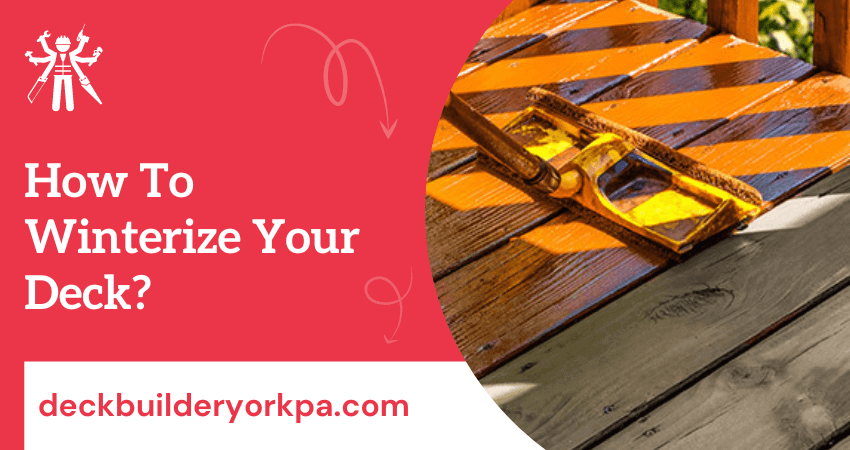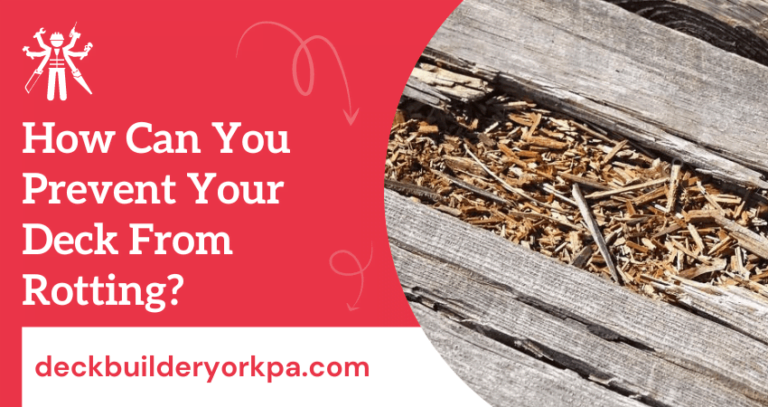How To Winterize Your Deck?
Winterizing your deck is an important step in maintaining its longevity and protecting it from harsh winter elements. By properly winterizing your deck, you can prevent damage from snow, ice and extremely cold temperatures and ensure that it is ready for use when spring arrives. It may seem overwhelming at first, but winterizing can be relatively easy when broken down into smaller steps so no need to worry!
In this guide, we will go over the steps to winterize your deck and keep it in top shape through the winter season. Whether you’re a seasoned DIYer or a beginner, these tips and tricks will help you prepare your deck for the winter months ahead.
So, keep reading to learn more about what specific steps you should take!
Steps To Winterize Your Deck
The winter season can be tough on decks, so it’s important to perform basic maintenance and winterize your deck before the cold weather sets in. By taking a few simple precautions, you can ensure that your deck lasts for years to come.
Here are some simple steps to help you winterize your deck:
1) Clean the deck
- Remove debris: Before you begin winterizing your deck, take the time to remove any debris left over from summer use. This includes leaves, pine needles, dirt and other debris that has built up on the deck’s surface.
- Sweep: Once all of the debris is removed, give the entire deck a thorough sweep to ensure that it is completely clean.
- Pressure wash: If your deck is particularly dirty, you may want to consider pressure washing it before beginning any other winterization tasks. This will help to remove any remaining dirt and grime, as well as any mold or mildew that may have started to grow.
- Allow the deck to dry completely: Once you have completed these steps, make sure to allow the deck to dry completely before beginning any additional winterization tasks.
2) Preparing for winter
- Seal cracks and gaps: To prevent snow and ice from entering the deck, it is important to seal any cracks or gaps that could allow moisture in. Using a silicone caulk or wood filler, apply a layer of material to all cracks or gaps to protect the deck from water damage.
- Sanding and staining: If the deck has not been stained or resealed recently, now is a good time to do so. Sanding the deck will help to remove any splinters and smooth out the surface.
- Apply water repellent: After the cracks and gaps are sealed, apply a water repellent to the entire surface of your deck. This will help to protect it from moisture damage as well as UV damage due to sun exposure.
- Cover or remove furniture: If you have outdoor furniture on your deck, it is important to either cover it or store it for the winter months. This will help to keep the furniture in good condition and prevent any damage due to snow or freezing temperatures.
- Seal the deck: Once your deck is clean and sanded, it’s important to seal it with a sealant. This will protect from the elements, helping to prevent further damage in the winter months. Make sure to apply multiple coats of sealant for maximum protection.
3) Protecting the railings and posts
- Applying a weatherproofing solution: To protect the railings and posts from damage due to snow, ice or freezing temperatures, it is important to apply a waterproofing solution. This can help to prevent rust and corrosion as well as preserve the longevity of your deck’s railing and posts.
- Protecting against frost heave: Frost heave occurs when colder temperatures cause the soil beneath your deck to expand and push up on it. To prevent this from happening, you can add a layer of insulation to the soil beneath your deck or use frost shields for extra protection.
- Apply sealant: To protect the railings and posts from damage due to moisture, it is important to apply a sealant. This will help to prevent water from seeping in and causing damage.
- Wrapping the railings and posts in insulation material: If you live in an area with extremely cold temperatures, it may be beneficial to wrap the railings and posts of your deck in insulation material. This will help to keep them warmer and less susceptible to damage due to freezing temperatures.
4) Maintaining the deck
In addition to the steps outlined above, it is important to regularly inspect and maintain your deck throughout the winter months. This includes
- Regular inspection: Regularly inspect the deck for any signs of wear and tear or damage due to snow, ice or freezing temperatures. Make sure to clean up any debris that may have accumulated during these months as well.
- Clearing snow and ice: If it snows or if ice accumulates on your deck, make sure to clear it away as soon as possible. This will help to prevent any moisture from seeping into the wood and causing damage.
- Re-sealing: It is also important to re-seal the deck once spring arrives to protect it from further weather damage. This will help to keep your deck looking its best and prevent any moisture from seeping in.
By following these steps, you can make sure that your deck remains safe, secure and in good condition throughout the winter season!
You May Hire: Professional For Deck Winterization
FAQs – Deck Winterization
Why is winterizing a deck important?
Winterizing a deck is important to prevent water damage, cracking, splitting and warping caused by freezing and thawing cycles during winter. It also helps to keep the deck in good condition, so it is ready for use in the spring.
What materials are needed to winterize a deck?
The materials needed to winterize a deck depend on the type of deck you have and your chosen method for protecting it from the elements. Generally, the materials needed to winterize a deck include a pressure washer, a cleaner specifically designed for decking, a sealant or stain and a brush or roller.
How do I clean my deck before winterizing it?
To clean your deck before winterizing it, start by removing any furniture and accessories, sweep the deck to remove loose dirt and debris, then wash it with a deck cleaner and a pressure washer. Let the deck dry completely before applying any sealant or stain.
What type of sealant or stain is best for winterizing a deck?
A water-repellent sealant or stain that contains a UV inhibitor is best for winterizing a deck. This will help protect the deck from water damage, fading and discoloration.
How often should I winterize my deck?
You should winterize your deck at least once a year to maintain its good looks and structural integrity. If you live in an area with extreme weather conditions, such as heavy snow or rain, you may need to winterize your deck more frequently.
Regular maintenance, such as cleaning and reapplying sealant or stain, will keep your deck looking great and extend its lifespan. It is also important to check your deck regularly for any signs of wear and tear, decay or rot. If you notice any damage, take the necessary steps to fix it before winterizing your deck again.
Final Thought
Winterizing your deck is a crucial step in protecting it from winter weather conditions. This can be achieved by cleaning and repairing any damage, sealing the surface and covering or removing outdoor furniture.
By taking these necessary steps, you can ensure that your deck is protected and ready for use when spring arrives. Proper winterization will also help extend the life of your deck and keep it looking great for years to come.







